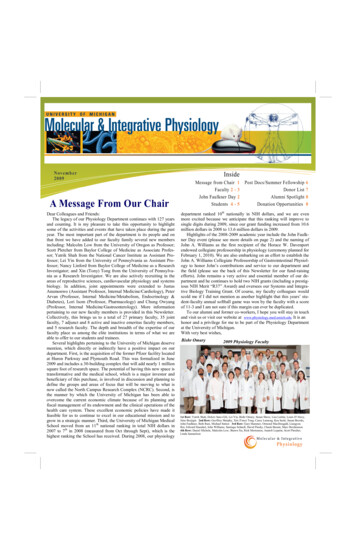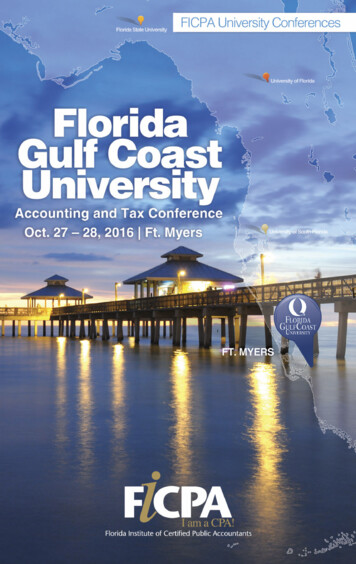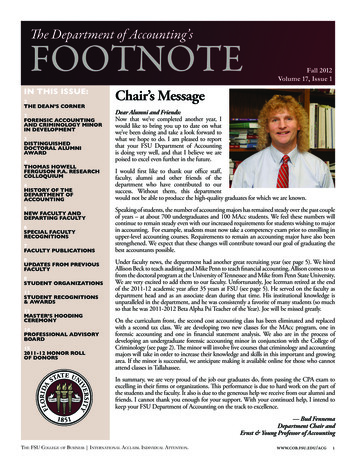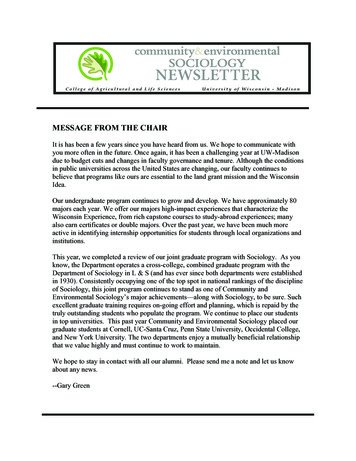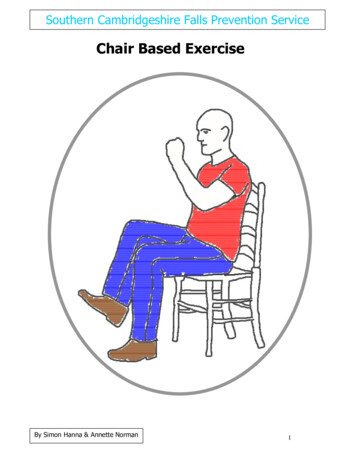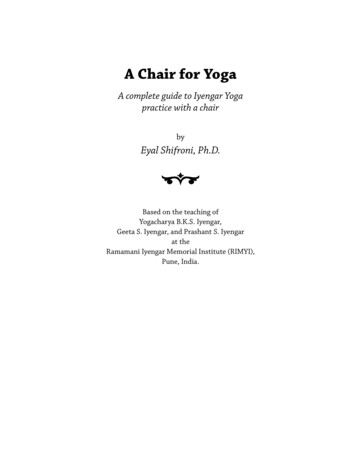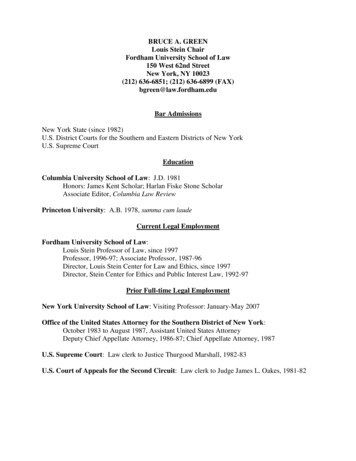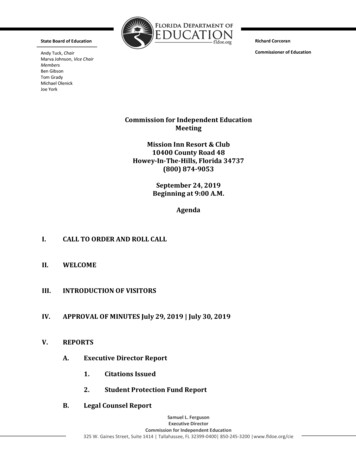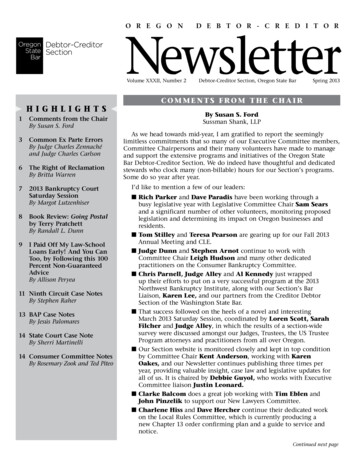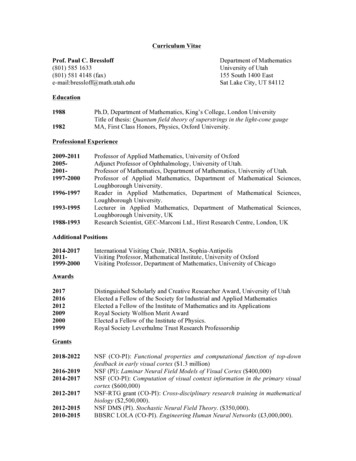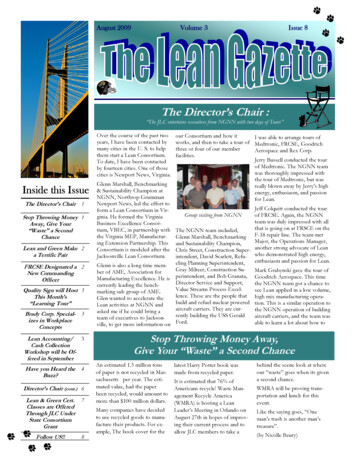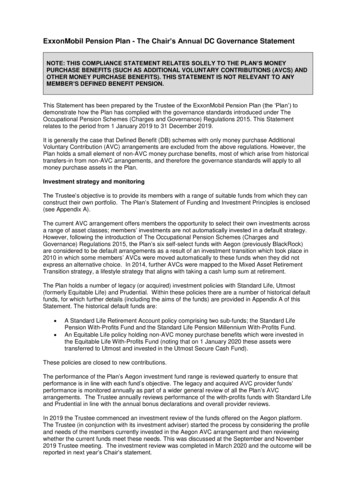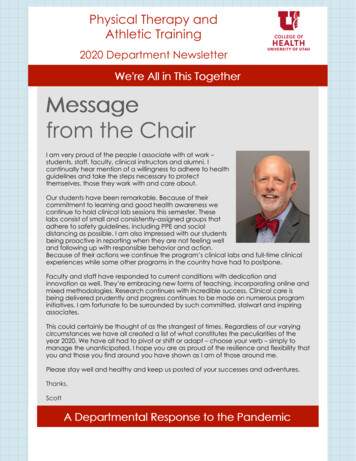
Transcription
Physical Therapy and Athletic Training2020 Department NewsletterWe're All in This TogetherMessagefrom the ChairI am very proud of the people I associate with at work –students, staff, faculty, clinical instructors and alumni. Icontinually hear mention of a willingness to adhere to healthguidelines and take the steps necessary to protectthemselves, those they work with and care about.Our students have been remarkable. Because of theircommitment to learning and good health awareness wecontinue to hold clinical lab sessions this semester. Theselabs consist of small and consistently-assigned groups thatadhere to safety guidelines, including PPE and socialdistancing as possible. I am also impressed with our studentsbeing proactive in reporting when they are not feeling welland following up with responsible behavior and action.Because of their actions we continue the program’s clinical labs and full-time clinicalexperiences while some other programs in the country have had to postpone.Faculty and staff have responded to current conditions with dedication andinnovation as well. They’re embracing new forms of teaching, incorporating online andmixed methodologies. Research continues with incredible success. Clinical care isbeing delivered prudently and progress continues to be made on numerous programinitiatives. I am fortunate to be surrounded by such committed, stalwart and inspiringassociates.This could certainly be thought of as the strangest of times. Regardless of our varyingcircumstances we have all created a list of what constitutes the peculiarities of theyear 2020. We have all had to pivot or shift or adapt – choose your verb – simply tomanage the unanticipated. I hope you are as proud of the resilience and flexibility thatyou and those you find around you have shown as I am of those around me.Please stay well and healthy and keep us posted of your successes and adventures.Thanks,ScottA Departmental Response to the Pandemic
The Physical Therapy Program'sResponse to the PandemicTransitioning Athletic Training During aPandemicWalk into the Health ProfessionalEducation Building on a weekday inSeptember 2020. You will hear studentsdiscussing the anatomy, physiology,and kinematics of the shoulder. You willhear discussions on an upcoming groupassignment and groans about studyingfor Pathokinesiology or Tests andMeasures, or some other class. Thesesounds are all too familiar to anycurrent or past physical therapystudent, but what you would see issomething very different.Like everything in March 2020, COVID19 brought athletic training to ascreeching halt. However, the AthleticTraining (AT) Program at the Universityof Utah was in the middle of a degreetransition. We had excitedly sent outacceptance letters to their first Masterof Athletic Training cohort just threeweeks before the shutdown. Suddenly,we were trying to determine if therewould be a traditional start to our newprogram. We also quickly pivoted ourbaccalaureate students to onlinelearning to make sure our graduatingstudents were ready for their futurecareers.Read moreRead moreCommunity OutreachThe Wellness BusThe Wellness Bus is part of a flagshipinitiative of a large gift from the Larry H.and Gail Miller Foundation to theUniversity of Utah. “Three years ago, TheFoundation gifted the university moneywith the hope of addressing the thediabetes epidemic in the state of Utahand beyond.” says Robin Marcus, PT, PhD,FAPTA, professor within the Department ofPhysical Therapy and Athletic Trainingand the University’s inaugural ChiefWellness Officer.Read more
A High-Flying Career with the Circus of CircusesBy Bill Keshlear, College of HealthUniversity of Utah alumna, Jaclyn Arduini,was backstage last year atthe Maverick Center in West Valley City,home of the Grizzlies, the minor leagueaffiliate of the professional hockey teamAnaheim Ducks. She was watching circusmagic, but her professional focus was thesame as it would’ve been anticipating a fullbody check.Read moreAlumni SpotlightsResearchAfter graduating from the University of Utah’s PhysicalTherapy program in 1984, Michele Basso, Ed.D, PT decidedshe wanted to teach. She was accepted to Teacher’sCollege at Columbia University and received a master’sdegree in Motor Learning from the Movement Sciences andEducation Department. However, something unexpectedhappened along the way: she discovered she had a brainfor research, she could see things from a research designperspective, confounding variables and point out factorsthat would mar interpretation. Soon, this discovery led herto an Ed.D. and set the stage for a career in brain andspinal cord research.Even as an undergraduate at the University of Utah, Dr. Basso demonstrated a talentfor research. She remembers a time in physical therapy school when the students werein a lab performing repeated measurements on the knee. She started to questionwhether the measurements would be valid due to inconsistencies of some peoplewearing pants and others not. After the lab, the instructor of the class, Gerard Brennan,came up to her and told her she had a really good mind for science. No one had eversaid anything like that to her before.It didn’t take long for Dr. Basso’s findings to gain an audience. Her first publication,written with fellow student Lo Knapp, while still in physical therapy school was publishedin the journal Physical Therapy in 1987. She explored a comparison of two continuouspassive motion protocols for patients with total knee implants. Since then, she has goneon to write and contribute to 77 scholarly articles, furthering her own natural curiosityand advancing neurologic research.Dr. Basso says the reason she is a scientist is simple, “I learn something new every day. Iget really excited when I see my research translate into practice”. Nowhere is thattranslation more apparent – or her excitement more evident – than in her pioneeringresearch in translating spinal cord injury improvements from an animal model
to people living with spinal cord injury.“Nothing in spinal cord injury is easy,” Dr. Basso says, but difficulty is exactly wherepeople like Dr. Basso can find success. Her lab is currently exploring the role myelinplays in neuroplasticity, recovery, and improvements in function. “Everything we knowabout motor learning, about recovery, about facilitating improvement in function andperformance is based on neuroplasticity,” she says. “We are now finding that myelin isa key player. Neuroplasticity doesn’t capture it all because now wehave myelin plasticity.”Along with her research, Dr. Basso enjoys watching her lab grow and change witheach new graduate student who joins her team. Because of one former gradstudent, her lab has a strong background in neuropathic pain; because of another, herteam has a foundation in animal models of rehabilitation strategies; and because ofanother, innovative new discoveries in myelin plasticity. “Graduate students drive someof the coolest science,” she says.Dr. Basso considers the training she received from the University of Utah PhysicalTherapy program as the whole package – providing strong science, foundationalknowledge and encouragement. She left the program ready to be engagedat the national level. The program prepared her to take on whatever would come nextin her career after graduation.ClinicalPhysical therapists know the value of patient-centeredcare. Stephen Hunter, PT, DPT, OCS, FAPTA, is noexception.Through research, clinical experience, and leading aDream Team of Internal Process Control experts, Dr. Hunter,a graduate of the University of Utah Department ofPhysical Therapy and Athletic Training, hasforged connections with therapists and patient-centeredcare.Thanks to his schooling at the U, both his undergraduatedegree in 1984 and his DPT in 2008, Dr. Hunter saw theimportant connection between research and howresearch guides the care that is delivered across an entirehealth system. Across all practice settings from acute, to home care, to outpatients,and with all rehabilitation providers including, physical therapy, occupational therapy,speech therapy, athletic training and audiology.As an undergraduate, Dr. Hunter worked in a muscular dystrophy clinic in the eveningsafter school and wrote his senior thesis on how physical therapists use the PT Journal intheir practice. He could see, even in his early career, how important evidence-basedpractice was to the profession of physical therapy.Upon graduating from the U, Dr. Hunter was hired by Intermountain Healthcare andgiven the task to develop content for their Back School. He was flown across the
country to meet with back programs and gather as much information as he could. Thisexperience, along with others, led to involvement in his first publication in the journalSpine. His article answered the question of what predicted return to work for railroadworkers with back injuries.Dr. Hunter quickly moved into management at Intermountain Healthcare where hemanaged 12 outpatient orthopedic physical therapy clinics. In 2018 whenIntermountain restructured their rehab facilities and Dr. Hunter became the Director ofthe Internal Process Control Team whose primary responsibility is to set standards,establish evidence based processes, and standardize education for their rehabprofessionals.Dr. Hunter has also been active within the APTA sitting on the scientific advisory boardfor the PT outcomes registry and working on the recent Total Knee Replacement CareProcess Guidelines.When a provider calls Dr. Hunter and says, because of you and your team we are nowdoing something different and patients are getting better faster, with fewer visits, andbetter outcomes, this is what is most exciting to him. Knowing that his work is translatingto the therapist-patient level and patients are getting better care because of it.Dr. Hunter stills sees patients one day a week in the clinic. “I pinch myself daily to makesure the career path I have been on is reality, not a dream!” Dr. Hunter says, reflectingon the trajectory that has brought him to this point. And he is grateful to the U forsetting him up for success. “The University of Utah prepared me for this”.Current StudentsThe University of Utah’s Physical Therapy and Athletic Training programs welcomestudents from around the country and the world. This graphicis an illustration of the geographic diversity of the programs' classes of2021-2023.New Faculty
Elizabeth Lane, PT, DPT, PhD,OCS, FAAOMPTCraig Switzler, DHSc, LAT,ATCElizabeth Lane is an AssistantCraig Switzler returns to theResearch Faculty withUniversity of Utah as thethe Department of PhysicalCoordinator of ClinicalTherapy and AthleticEducation for the AthleticTraining. She earned herTraining Program.doctorate in physical therapyHe completed hisfrom the Medical College ofundergraduate degree inGeorgia and Ph. D. inExercise and Sport ScienceRehabilitation Sciences fromwith an emphasis in Athleticthe University of Utah. She hasTraining at University ofcompleted residency training Utah. He earned his athleticin orthopedics and manualtraining posttherapy fellowship training.professional Masters ofHer teaching responsibilitiesScience at University ofinclude orthopedicOregon in the Departmentassessment and intervention.of Human Physiology. HeHer research interests arereceived a doctorate intreatment of low back pain,Health Sciences with anpain science, and dryemphasis in education fromneedling. She has served onA.T. Still University of Mesa,the Residency and Fellowship Ariz. He has worked over 15Education Special Interestyears as an athletic trainer inGroup for the Academy ofa variety of settings,Education of the Americanincluding small and largePhysical Therapyuniversity athletics,Association.industrial, inpatient andoutpatient clinics, performingarts, and high school.Eric Robertson, PT, DPT, OCS,FAAOMPTEric Robertson isan Associate Clinical Professor within theDepartment of PhysicalTherapy and AthleticTraining. Previously he servedas assistant professor ofphysical therapy at RegisUniversity in Denver,Colorado, and the Universityof Texas at El Paso. Hereceived his bachelor’sdegree in physical therapyfrom Quinnipiac Universityand his doctor of physicaltherapy (DPT) degree fromBoston University. He is boardcertified in orthopedics and aFellow of the AmericanAcademyof Orthopaedic ManualPhysical Therapists(FAAOMPT). Dr. Robertson’sresearch interests lie in healthservice utilization, evidencebased practice, clinicalreasoning, and exploring theimpact of technology onhealth care.DPT Program ExpansionSt. George Satellite ProgramThe DPT program is pleased toannounce an extension of the currentDoctor of Physical Therapy (DPT) degreeto be offered at the University of Utah DPTon site in St. George, Utah. This degreeprogram is housed in the Department ofPhysical Therapy and Athletic Training
within the College of Health.Read moreHybrid ProgramThe department is exploring thedevelopment of a hybrid, distance-basedDPT program. In this program, students willbe able to live anywhere around thecountry and complete a majority of thiscoursework at a distance. Students wouldmake several trips to campus for labimmersions and the clinical educationportion of the curriculum stay the same.Read moreAlumni UpdatesEvan Papa, PT, DPT, PhDWendy D. Bircher, PT, EdDI am the program director atUpon graduation, I workedthe Idaho State Universitywith birth to 3 yr olds withphysical therapy program.birth defects and medicallyWe recently expanded ourfragile programs on thecohort size from 24 to 48, andNavajo Reservation for 28opened a new site in Boise. I years. Following that, I was awas recently awarded anclinical director and thenNIH grant through NIGMS toprogram director of the PTAstudy the effect of aprogram at San Juan Collegecommunity-based exercisein Farmington, NM. Whileprogram to reduce falls inthere, I developed the firstpersons with Parkinson’saccredited Online Hybrid PTAdisease.Program, in the nation. I amSharik Peck, PTI have created a medicaldevice, an external vagusnerve stimulator that ishelping many peoplethroughout the world. Wehave 3 patents on thedevice with 2 morepending. It is most known forits help with TBI, migraineheadaches, and TMJ/TMD.
also the author of“Documentation for PTA’s”published by F. A. Davis.Beatriz Sunderland-White, PTAfter graduating from theUofU, most of my career as aPT has been based inOregon. I did a 1-year travelPT assignment that took meto Florida and NorthCarolina. I lived in SaudiArabia for 3 years for myhusband's job. We had 2boys, who are now 9 and 7years old. In 2018, I startedmy own practice in Portland,Oregon, specializing inWomen's Health workingpredominantly with pre andpostpartum women. Covid19 turned everything upsidedown and I left my practiceto be able to navigate thecrazy times we are living. InJuly of this year, we movedto Guam for a 2 yearassignment for my husband'sjob. I hope to continue mywork as a PT here in Guamonce my kids are back inschool.Alison McKenzie, PT, MA, DPT,PhDI am currently a tenuredprofessor and Director ofAnatomy Lab Operations inthe Dept. of Physical Therapyat Chapman University inOrange County, CA, where Iam also serving as theFaculty Senate President thisyear. I am also a ProjectScientist at the University ofCalifornia, Irvine, CA and aminvolved in stroke-relatedresearch. In addition, Ifounded and lead an interprofesisonal, integratedclinical education programof intensive strokeintervention (Stroke BootCamp) and co-founded twonon-profit organizations forclinicians, researchers,individuals with stroke, andcaregivers. Last year, Ireceived the APTA's SocietalImpact Award for my work instroke.Emma Johnson, PT, DPTSince graduating from the U Ihave been working at theUofU Hospital in critical careon the Medical ICU. Ithoroughly enjoy that thisenvironment is alwayschanging and challengingand now includes caring forour sickest patients withCOVID-19. For the past twoyears I have been teachinglabs and some lectures forthe CardiopulmonaryManagement course for theU's PT program. Currently I amgetting more involved invalue improvement and amworking on a project toimprove efficiency of PTorders and treatment timewithin the hospital.
Anne Houser, ATCFor the past six years I havebeen extensively involved inproviding outdoor recreationopportunities to individualswith various disabilities,though working with spinalcord injury athletes are myfavorite. I am on severalcommittees for the AmericanCanoe Association, includingthe Universal PaddlingCommittee, AdvancedCommunications SubCommittee, and Intro toPaddling committee.Through my work with theACA, I helped develop anew curriculum to teachACA instructors how to teachpaddling to paddlers withvisual impairments, hearingimpairments, and speechimpairments. I continue toteach paddling to individualswith physical disabilities,which is where I use much ofmy knowledge of anatomyand biomechanics learned inmy undergrad, to adaptequipment so thoseindividuals can be efficientpaddlers, regardless of theirdisability. After working inadaptive sports for the past 6years, I am now pursuing aMaster's degree in SocialWork at the University ofUtah.Gayanne Grossman PT, EdM,BFA, FIADMSThanks to Kent Allsop'sguidance, I have had awonderful career as aperforming arts medicinephysical therapist with aspecialization in dance since1988. I am the author of thetextbook Dance Science. Iserve the InternationalAssociation for DanceMedicine and Science(IADMS) on the Board ofDirectors, the ExecutiveCommittee, and as Treasurer.I have been the Editor-inChief of the IADMS Bulletin forDancers and Teachers since2009. My research focuses ondance, measuring turnout,tibial torsion, functionalanatomy, and most recentlyhypermobility in dancers. Iam faculty for the PerformingArts Medical Association(PAMA) certification inperforming arts medicine. Iteach Anatomy andKinesiology and am theDirector of Dance Wellness atMuhlenberg College. Iformerly taught kinesiologyand cared for the dancers atTemple University. I alsocared for the dancers at thePennsylvania Ballet andbefore that at the Universityof Utah. Thank you to theUniversity of Utah for greattraining in physical therapy.Valerie Schwalbe, PT, DPTIn 2018, I opened the firstPhysical Therapy clinicexclusive to pelvic healthconditions (for all) in thestate. Since then, we havegrown to 3 therapists, allpelvic health providers. Weare a cash-based clinic. Ihave been enjoying workingdirectly on patients' needs,providing direct care, andhav been able to introducenew graduates to this clinictype. I have build greatrelationships with thecommunity, including doulas,midwives, integrativemedicine, metal healthprofessionals, Urology,OBGYN, and GI. Weparticipate in communityevents, podcasts, andprovide our clinic for eventsand continuing educationopportunities. I have beenproud of the clinic, it'sgrowth, the safe andvalidating space it provides,my fellow therapists' support,and communityengagement to raiseawareness and normalize thetreatment of these issues.
Nathan J. Savage, PhD, DPT,ECS, OCS, RMSKI operate an outpatientorthopedic and sportsmedicine clinic in SouthIan Staley, Captain InfantryOgden. Since completing aUS Army, ATCPhD in Rehabilitation ScienceI have published peerI graduated and thenreviewed papers in Europeancommissionedas an InfantrySpine Journal and JOSPT onofficerintheUnitedStateselectrodiagnostic testing inArmy.I'velivedandpatients with sciaticadeployed in over tenreceiving physical therapy.countriesand led Soldiers forSince graduating I haveoversevenyears. As anobtained board certificationofficerandleaderin thein Clinical ElectrophysiologyArmy,especiallytheinfantry,and have become the onlywe are required to train ourphysical therapist in Utah toSoldiersto a high standard ofcertify in musculoskeletalhealthand fitness to makeultrasonography (RMSK). Mysureweare always ready forclinic specializes inanything.I've used myorthopedics and includesunique background to trai
knowledge and encouragement. She left the program ready to be engaged at the national level. The program prepared her to take on whatever would come next in her career after graduation. Clinical Physical therapists know the value of patient-centered care. Stephen Hu
